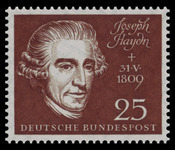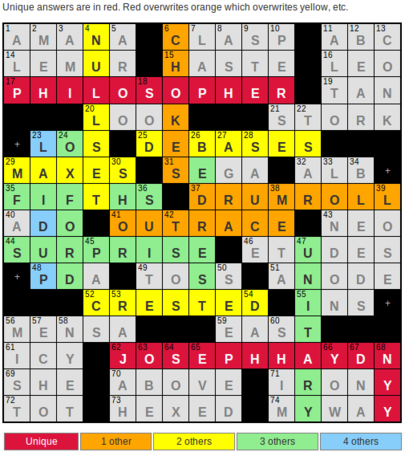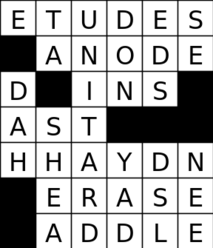Puzzle Solution #6: Hiding in Plain Sight
 A friend reminded me on Friday that I had not yet posted the solution to my latest crossword. My apologies to those of you waiting on the edge of the seat you use while working on my puzzles. I know some of you still solve these the old-fashioned way—on paper—and don’t have access to a solution until posted here. (But in fact the solution to the final version of this puzzle has been available all along at the George Barany & Friends website.)
A friend reminded me on Friday that I had not yet posted the solution to my latest crossword. My apologies to those of you waiting on the edge of the seat you use while working on my puzzles. I know some of you still solve these the old-fashioned way—on paper—and don’t have access to a solution until posted here. (But in fact the solution to the final version of this puzzle has been available all along at the George Barany & Friends website.)
As is my custom, I include some “spoiler space” at this point for those of you who missed the opportunity to do this puzzle earlier (perhaps you are just now waking up from a very long nap?). You can click this handy link to travel back in time to when the puzzle was brand new.

The spoiler in the space above belongs to the 2007 Toyota Prius we sold a few days ago. I never did figure out why it needed a spoiler, but it had one. We will miss that car. We do still have our red one to go with the Toyota conversion van that will haul me and my wheelchair around.
Here, presented in vivid technicolor courtesy of the www.xwordinfo.com website, is the solution to the “late beta” version of my puzzle:[1]

If you worked on the final copy of my puzzle—the one posted on the George Barany & Friends website—then the south east corner of the solution differs. See below or download a PDF copy from George’s site.
—
What did I learn by working for the first time with a real-life, talented crossword constructor? A lot …
I am working too hard.
Crossword Compiler for Windows takes much of the drudgery out of the job of puzzle construction: input an idea for a theme (or simply three or four long, interesting answers) and it can very often construct a grid and a complete solution–with all of the “fill” plugged in and ready to be clued. Of course, a talented constructor would never rely entirely on the program’s solution. George does not. He uses the program to help with some of the tedious tasks before building on what it can provide, relying on his long experience, a library of carefully vetted clues from his previous puzzles, and the fabulous resource of the GB and Friends beta testing team to produce a finished product.
I don’t have a copy of this program. What do I do instead? I use a Linux program to create two images of a grid I design: one empty and one showing the solution. It also exports a list of answers to which I can refer when using a word processing program to create my PDF. I wrote a script that takes the same list of exported answers and does most of the work needed to create a file from which Across Lite creates the playable puz file. It is a tedious process and I “hand enter” every answer in the puzzle. To help, I use a crude search script I originally wrote for Scrabble study to find possible fill from a limited crossword database found online.
Will I buy Crossword Compiler For Windows? No, I think I prefer to treat the construction of puzzles as a challenge much like the solving of puzzles. This preference will limit the number of puzzles I create.
The last 10% of any project takes 90% of the effort.
This is a truism in almost any endeavor and I’ve always found it a bugger. I seldom push past this 90% barrier in anything I do. I am a serial underachiever. For example, I conceived lots of brilliant ideas during my years as a computer programmer. Well, perhaps only some of them were brilliant. It is hard to know, because I invariably lost interest after completing about 90% of the work necessary to bring a project close to perfection.
I bring that same work ethic to the job of crossword puzzle construction. In this case, at least, I had George to push and prod me. It helped. At times, I was ready to settle for serious flaws. We got past those and it is a better puzzle for that extra effort.
Tastes vary.
George suggested several clues that were clearly superior to ones I had written (my favorite, particularly during the Olympic Games: TAN = “Go for the bronze?”). In a few cases, though, I acceded to his experienced eye where I liked my own clue. In one example, my clue for OBE was “McCartney was knighted in 1997; Harrison declined this lesser honor in 2000: Abbr.” I strongly preferred this to “Honor declined by George Harrison: Abbr.” I’ve seen OBE used as an answer in many puzzles; I wanted to add something of interest in the clue. Lots of people have declined the OBE. Why did Harrison decline it? Moreover, my clue at least hints to what kind of award may have been declined. But there is a strong preference among the most serious solvers and constructors for brevity in clues.[2]
In another matter that basically came down to taste, I did not want to clue FIFTHS and ETUDE with direct references to the composer. I felt that the theme of the puzzle was nicknames for Haydn symphonies and that these two clues did not fit. Further, I did not like the clue for ETUDE (a reach) and I wanted to leave FIFTHS as an “Easter egg.” (See the puzzle’s “midrash” for more on that.)
Not only clues were affected. In one case I changed a pair of answers (from POS/PAIDUP to LOS/LAIDUP) though I didn’t really see a clear advantage to either pair. In the event, LOS gave me a chance to use an up-to-date pop culture reference, so the change probably was a good one. The other case forms the primary difference between what I have called my “late beta” version and the finished one as published on the George Barany & Friends website. Below on the left is my version. On the right, George’s.


George felt that UNITARD was a more interesting answer than UNITARY. I would agree. Nouns often seem to be better choices than adjectives. But its use came at the cost of swapping SHIM, YOW, DNA, NYY, IRONY and MYWAY for SHEA, YAD, DSL, NEE, ERASE and ADDLE. I did not like the trade. But this is pretty clearly a matter of taste and personal preference.
—
As I reread the above, I am concerned that it comes across as negative. I don’t mean it to be. Let me be clear, I enjoyed the process of working with George as an editor on this puzzle. Despite my niggling differences of opinion, I have no doubt that his suggestions overall made this puzzle much better. (Not to mention the helpful feedback from his impressive group of beta-testers.) Sometime in the next month or so, I hope to submit another to him for consideration. My goal is to do such a good job on it that he will want to accept it without any major changes and that beta-testers will agree. We’ll see.
| DATE | TITLE |
| 04/24/2020 | #k1: Meadow’s First! |
| 04/20/2020 | #24: Roadside Attractions? |
| 02/20/2020 | #23: World’s Smallest! |
| 06/20/2018 | #22: Northern Dialect |
| 01/30/2018 | #21: Special Editions |
| 10/10/2017 | #20: Saints We’d Like to See |
—
Notes
- The color-coded key refers to the number of times a word has appeared in a New York Times crossword puzzle since 1994. [^]
- One thing I was surprised to learn recently is that NYT crossword editor Will Shortz changes approximately 1/3 of the clues written by constructors of the puzzles he accepts for publication. [^]
